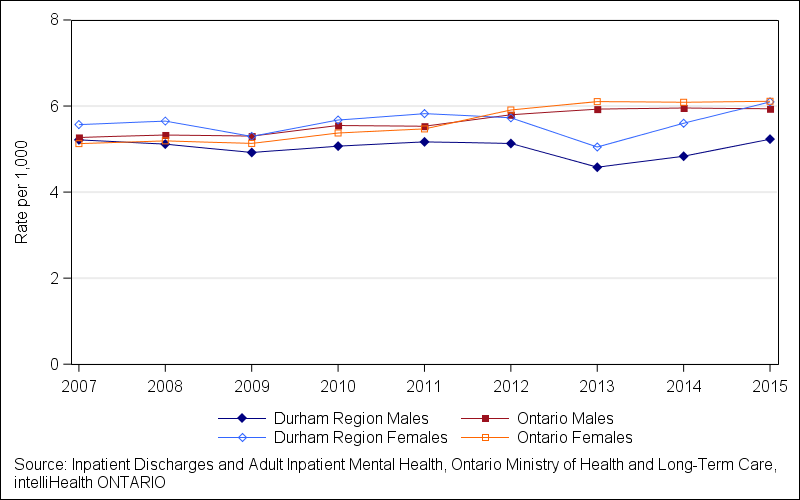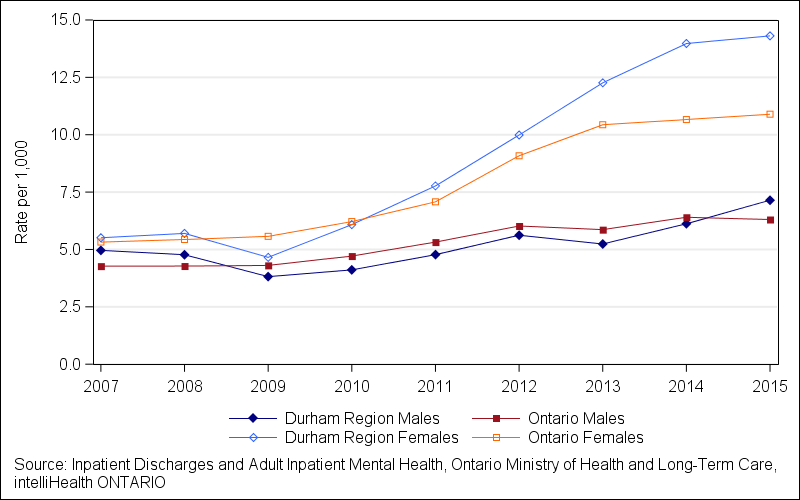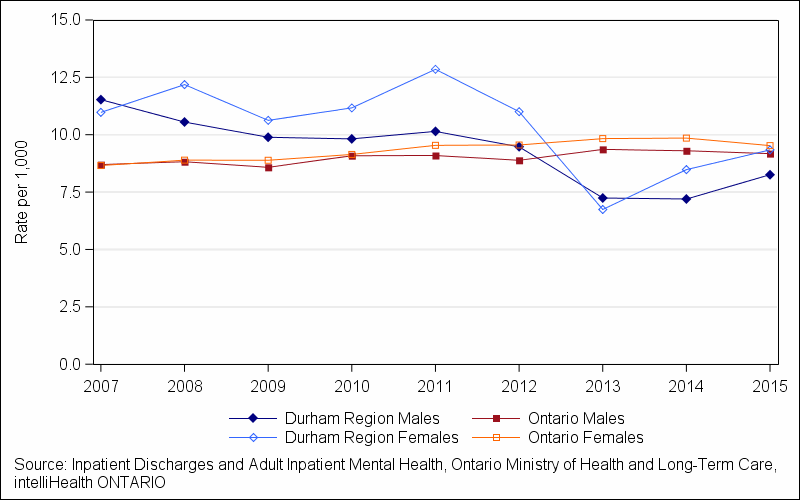
Mental Illness At a Glance
Release date: August 2017
Introduction
Figures and tables are provided for the following indicators of mental illness for Durham Region:
- Age-standardized prevalence of mental illness hospitalizations by sex
- Age-specific prevalence of mental illness hospitalizations by sex for individuals 15 to 19 years
- Age-specific prevalence of mental illness hospitalizations by sex for individuals 65 years and older
Related information
The following websites provide additional local information on indicators of mental illness health system performance and characteristics.
Canadian Institute for Health Information Health Indicators Interactive Tool
For more detailed, topic-specific reports on mental health and wellness, please go to the Durham Health Stats page.
For more information or if you require this information in an accessible format, please contact Durham Health Connection Line at 905-666-6241 or 1-800-841-2729.
Please contact the author to request a PDF copy of this document.
Indicators of mental illness
Mental illness hospitalizations by sex
As shown in figure 1 below, since 2007, the prevalence rates of mental illness hospitalizations in Durham Region females increased while the rates for males remained stable. Comparatively, the prevalence rates of mental illness hospitalizations in Durham Region females were higher than the rates in Durham Region males. In 2015, 3,723 individuals were hospitalized at least once in the same year due to mental illness. For the same year, as compared to Ontario, the prevalence rate of mental illness hospitalizations in Durham Region females was similar while the rate in Durham Region males was lower.
Figure 1. Age-standardized prevalence of mental illness hospitalizations for Durham Region and Ontario, by sex, annual rate per 1,000 between 2007 and 2015

| Data table for Figure 1 | ||||||||||||||||||||||||||||||||||||||||||||||||||||||||||||||||||||||||||||||||||||||||||||||||||||||||||||||||||
|
||||||||||||||||||||||||||||||||||||||||||||||||||||||||||||||||||||||||||||||||||||||||||||||||||||||||||||||||||
| Statistic | Calendar year | ||||||||
|---|---|---|---|---|---|---|---|---|---|
| 2007 | 2008 | 2009 | 2010 | 2011 | 2012 | 2013 | 2014 | 2015 | |
| Durham Region Females rate | 5.6 | 5.7 | 5.3 | 5.7 | 5.8 | 5.7 | 5.0 | 5.6 | 6.1 |
| Durham Region Females count | 1,593 | 1,652 | 1,578 | 1,747 | 1,829 | 1,843 | 1,665 | 1,871 | 2,065 |
| Durham Region Males rate | 5.2 | 5.1 | 4.9 | 5.1 | 5.2 | 5.1 | 4.6 | 4.8 | 5.2 |
| Durham Region Males count | 1,345 | 1,359 | 1,333 | 1,415 | 1,463 | 1,508 | 1,394 | 1,508 | 1,658 |
| Ontario Females rate | 5.1 | 5.2 | 5.1 | 5.4 | 5.5 | 5.9 | 6.1 | 6.1 | 6.1 |
| Ontario Females count | 33,300 | 34,188 | 34,278 | 36,406 | 37,586 | 41,069 | 42,971 | 43,386 | 43,908 |
| Ontario Males rate | 5.3 | 5.3 | 5.3 | 5.5 | 5.5 | 5.8 | 5.9 | 6.0 | 5.9 |
| Ontario Males count | 31,761 | 32,486 | 32,756 | 34,769 | 35,168 | 37,579 | 38,987 | 39,725 | 40,115 |
| Source: Inpatient Discharges and Adult Inpatient Mental Health, Ontario Ministry of Health and Long-Term Care, intelliHEALTH ONTARIO | |||||||||
Mental illness hospitalizations in youth aged 15 to 19
The prevalence rates of mental illness hospitalizations in youth aged 15 to 19 increased between 2007 and 2015 in Durham Region (see figure 2 below). There was a three-fold increase in the rate for Durham Region females within this age group by 2015. In 2015, Durham Region youth accounted for 13 per cent (478 out of 3,723) of the total number of individuals hospitalized at least once in the same year due to mental illness. The prevalence rates of mental illness hospitalizations in Durham Region females and males were higher than Ontario. Since 2007, the prevalence rates of mental illness hospitalizations in Durham Region females were consistently higher than the rates in Durham Region males.
Figure 2. Age-specific prevalence of mental illness hospitalizations, by sex, in Durham Region and Ontario for individuals 15-19 years, annual rate between 2007 and 2015

| Data table for Figure 2 | ||||||||||||||||||||||||||||||||||||||||||||||||||||||||||||||||||||||||||||||||||||||||||||||||||||||||||||||||||
|
||||||||||||||||||||||||||||||||||||||||||||||||||||||||||||||||||||||||||||||||||||||||||||||||||||||||||||||||||
| Statistic | Calendar year | ||||||||
|---|---|---|---|---|---|---|---|---|---|
| 2007 | 2008 | 2009 | 2010 | 2011 | 2012 | 2013 | 2014 | 2015 | |
| Durham Region Females rate | 5.5 | 5.7 | 4.7 | 6.1 | 7.8 | 10.0 | 12.3 | 14.0 | 14.3 |
| Durham Region Females count | 126 | 134 | 111 | 145 | 185 | 234 | 281 | 313 | 313 |
| Durham Region Males rate | 5.0 | 4.8 | 3.8 | 4.1 | 4.8 | 5.6 | 5.2 | 6.1 | 7.1 |
| Durham Region Males count | 118 | 116 | 94 | 102 | 119 | 139 | 127 | 145 | 165 |
| Ontario Females rate | 5.3 | 5.4 | 5.6 | 6.2 | 7.1 | 9.1 | 10.4 | 10.7 | 10.9 |
| Ontario Females count | 2,289 | 2,365 | 2,438 | 2,723 | 3,098 | 3,930 | 4,447 | 4,465 | 4,472 |
| Ontario Males rate | 4.3 | 4.3 | 4.3 | 4.7 | 5.3 | 6.0 | 5.9 | 6.4 | 6.3 |
| Ontario Males count | 1,914 | 1,930 | 1,952 | 2,153 | 2,444 | 2,752 | 2,645 | 2,840 | 2,743 |
| Source: Inpatient Discharges and Adult Inpatient Mental Health, Ontario Ministry of Health and Long-Term Care, intelliHEALTH ONTARIO | |||||||||
Mental illness hospitalizations in adults 65 and older
Between 2007 and 2015, the prevalence rates of mental illness hospitalizations in adults 65 and older decreased in Durham Region. Adults 65 and older accounted for 22 per cent (809 out of 3,723) of the total number of individuals in Durham Region hospitalized at least once due to mental illness in 2015. In 2015, the prevalence rates of mental illness hospitalizations in Durham Region females and males were lower than Ontario. Between 2007 and 2015, the prevalence rates of mental illness hospitalizations in Durham Region females were higher than the rates in Durham Region males of this age group (see figure 3 below).
Figure 3. Age-specific prevalence of mental illness hospitalizations, by sex, in Durham Region and Ontario for individuals 65 years and older, annual rate between 2007 and 2015

| Data table for Figure 3 | ||||||||||||||||||||||||||||||||||||||||||||||||||||||||||||||||||||||||||||||||||||||||||||||||||||||||||||||||||
|
||||||||||||||||||||||||||||||||||||||||||||||||||||||||||||||||||||||||||||||||||||||||||||||||||||||||||||||||||
| Statistic | Calendar year | ||||||||
|---|---|---|---|---|---|---|---|---|---|
| 2007 | 2008 | 2009 | 2010 | 2011 | 2012 | 2013 | 2014 | 2015 | |
| Durham Region Females rate | 11.0 | 12.2 | 10.6 | 11.2 | 12.8 | 11.0 | 6.7 | 8.5 | 9.3 |
| Durham Region Females count | 389 | 450 | 407 | 445 | 534 | 484 | 312 | 411 | 473 |
| Durham Region Males rate | 11.5 | 10.6 | 9.9 | 9.8 | 10.1 | 9.5 | 7.2 | 7.2 | 8.3 |
| Durham Region Males count | 312 | 300 | 293 | 304 | 330 | 329 | 267 | 279 | 336 |
| Ontario Females rate | 8.7 | 8.9 | 8.9 | 9.1 | 9.5 | 9.6 | 9.8 | 9.9 | 9.5 |
| Ontario Females count | 8,257 | 8,681 | 8,887 | 9,369 | 10,049 | 10,479 | 11,218 | 11,637 | 11,616 |
| Ontario Males rate | 8.7 | 8.8 | 8.6 | 9.1 | 9.1 | 8.9 | 9.4 | 9.3 | 9.2 |
| Ontario Males count | 6,380 | 6,677 | 6,695 | 7,313 | 7,580 | 7,781 | 8,592 | 8,887 | 9,099 |
| Source: Inpatient Discharges and Adult Inpatient Mental Health, Ontario Ministry of Health and Long-Term Care, intelliHEALTH ONTARIO | |||||||||
Data sources
The Ontario Mental Health Reporting System (OMHRS) is an administrative database that provides information about inpatients occupying designated adult mental health hospital beds. This includes general hospitals with designated adult mental health beds, as well as speciality psychiatric hospitals and provincial psychiatric hospitals. The Discharge Abstract Database (DAD) is an administrative database that captures information on acute inpatient hospital care, including day surgery, upon discharge (deaths, sign-outs and transfers). In most cases, DAD collects information on child and adolescent mental health care (approximately two per cent of cases in the OMHRS are individuals under the age of 18).
While OMHRS is an admission-based system and the DAD is a discharge-based system, data from both systems are used to report on mental illness hospitalizations. Both databases submit information to the Canadian Institute for Health Information (CIHI) on behalf of the Ontario Ministry of Health and Long-Term Care (MOHLTC). These rates do not represent the true prevalence of mental illnesses as persons with less severe or undiagnosed mental illnesses are excluded.
The mental illnesses examined in this report were classified according to the Diagnostic and Statistical Manual of Mental Disorders, Fourth Edition (DSM-IV) and according to the International Classification for Diseases, 10th revision, Canadian Enhancement (ICD-10-CA).
For hospital admissions captured in OMHRS, patients with mental illness were selected using the diagnostic categories of substance disorder, psychotic disorder, mood disorder, anxiety disorder or adjustment disorder as the primary, secondary or the tertiary diagnosis. For hospitalizations captured in DAD, patients with mental illness were selected using ICD-10-CA codes F10-F19, F20-F29, F30-F39, F40-F48, F60-F69 as either the primary reason for the hospital stay or a comorbid condition.
An individual may be hospitalized several times each year or in subsequent years for mental illness. As such, the encrypted health card number, a unique number, was used to count the number of individuals discharged at least once from a hospital or admitted at least once to an adult mental health bed on an annual basis.
Data were analyzed by the residence of the individual, not where the hospital admission or discharge occurred. Ontario residents treated outside of the province were excluded. Data were reported by calendar year, based on discharge or admission year of the hospitalization.
This report acknowledges the contribution of Jasantha Naidoo and her report to the Office of the Medical Officer of Health, Peel Public Health, August 2014 as part of her Master of Public Health practicum placement, entitled Analysis of the Ontario Mental Health Reporting System: Examining its Usefulness to Peel Public Health (unpublished).
Definitions
Age-standardized prevalence of mental illness hospitalizations
The number of individuals with at least one hospitalization (such as being discharged from a general hospital or admitted to a designated acute mental health bed) per 1,000 population for the same year that would have occurred if the population had the same age distribution as the 2011 Canadian population.
Age-specific prevalence of mental illness hospitalizations
The number of individuals with at least one hospitalization (such as being discharged from a general hospital or admitted to a designated acute mental health bed) in a specified age group per 1,000 population in that age group for the same year.
Contact Us




